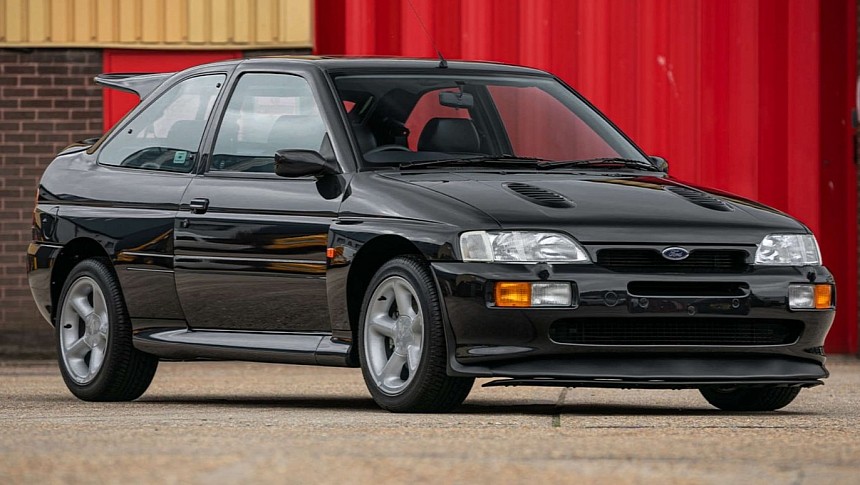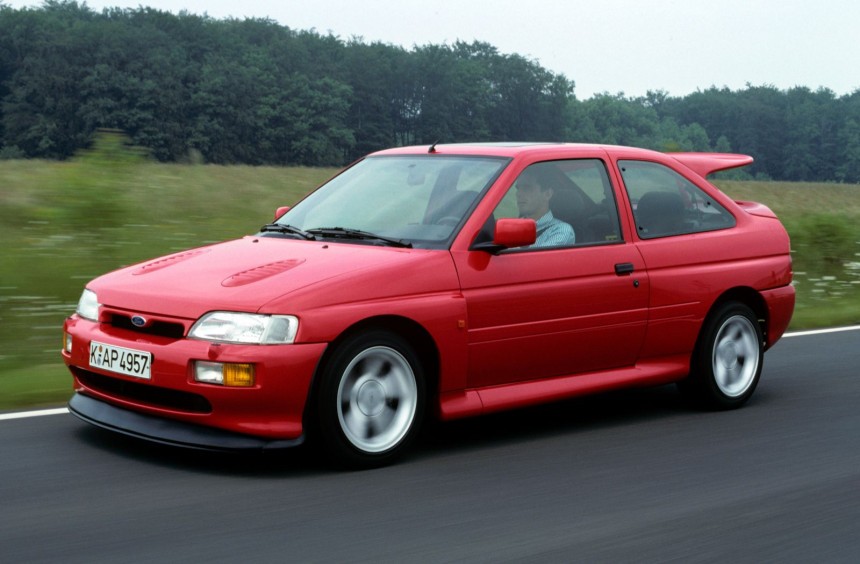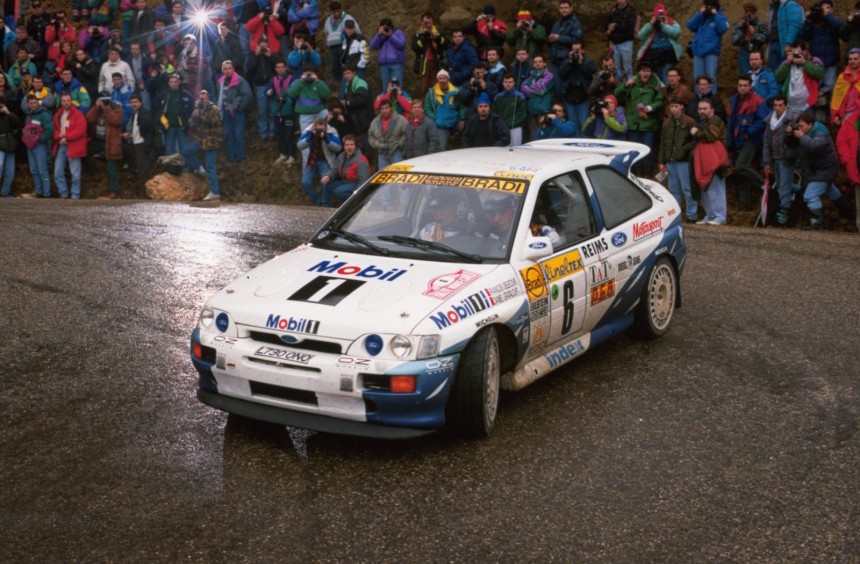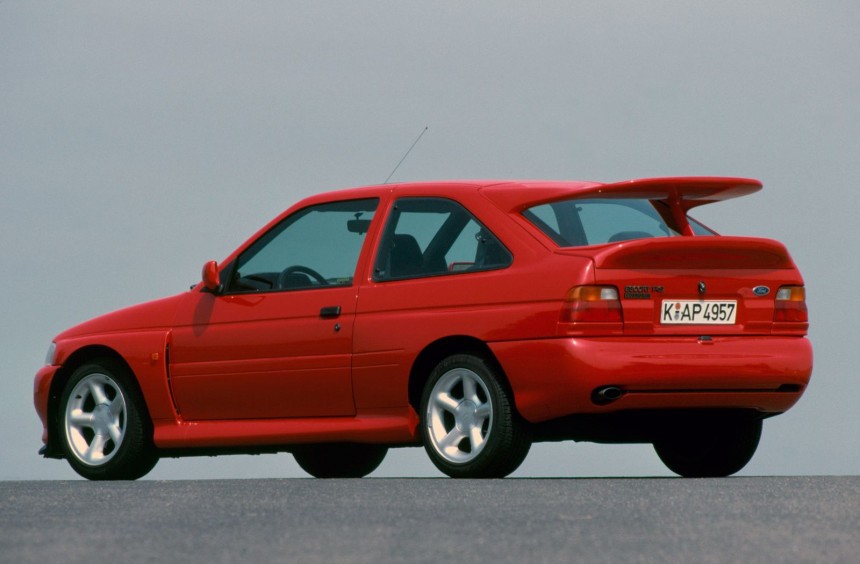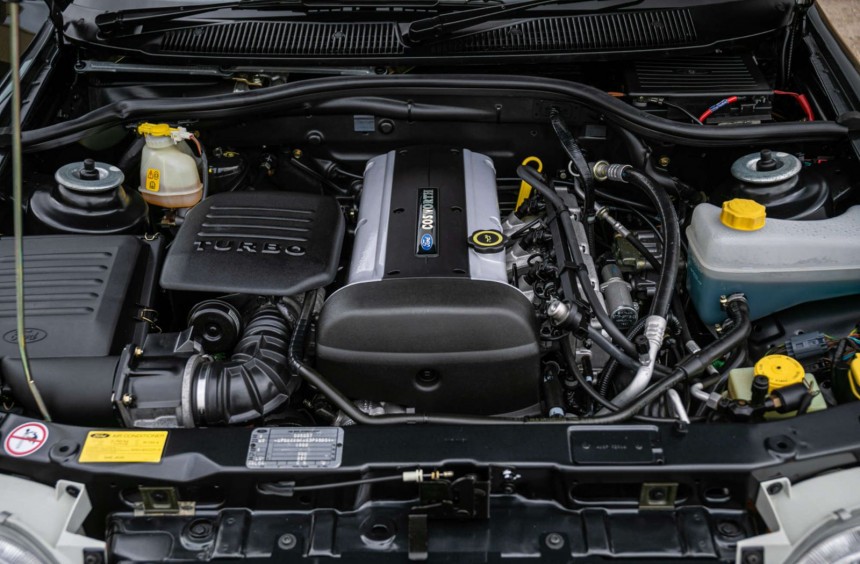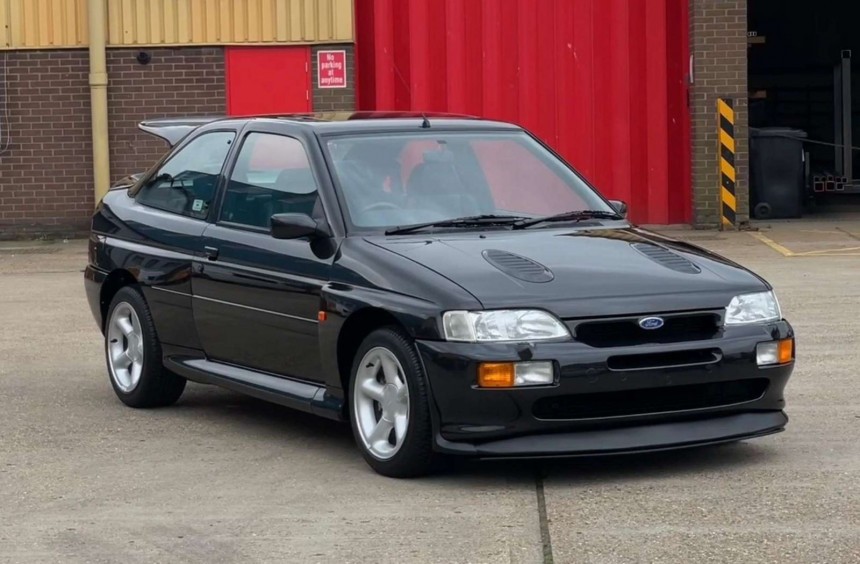From a pure motorsport perspective, the Escort RS Cosworth was a failure for Ford. However, the homologation specials it spawned were - and still are - some of the most thrilling road-legal performance cars to don Blue Oval badges.
When we think about legendary homologation specials from the 1990s, cars like the Mitsubishi Lancer Evo, Lancia Delta HF Integrale, Subaru Impreza WRX STi, or Toyota Celica GT-Four come to mind.
All of them were thoroughly modified, all-wheel-drive, rally-bred versions of otherwise plebian models constructed with a single goal in mind: dominate the World Rally Championship (WRC). And as it turned out, all managed to do just that.
This leads us to the Ford Escort RS Cosworth, which was put together following the same recipe but failed to achieve WRC glory. Despite that, the road-legal homologation specials born out of this project were some of the most viscerally thrilling hot hatches ever built, and today, they're usually more sought-after than most of the WRC-winning specials from the same era.
Ford was a constant presence in the WRC for decades, but its last title came in 1979 with the Escort RS1800. During the exciting but short-lived Group B epoch of the 1980s, the Blue Oval tried to get back on top with its mid-engine RS200. Unfortunately, Audi with its Quattro and Peugeot with its small, mid-engine 205 Turbo 16 proved virtually unbeatable.
Mid-way through the 1986 season, FIA decided to cancel the Group B, citing safety concerns, so the tamer Group A became rallying's top category in 1987.
With the rulebook specifying that a manufacturer could enter the competition only if it could build 5,000 road-legal examples of the rally car in a twelve-month span, Ford tuned to its Sierra RS Cosworth.
However, this model was initially a rear-wheel-drive homologation special for touring car races, so it proved to be no match for the four-wheel-drive machines of the WRC, particularly on the special stages.
After two disastrous seasons of campaigning the RWD Sierra Cossie, Ford launched the 4WD version in 1990, but despite its improved drivetrain, it was just too large and heavy, failing to win a single event in three full seasons.
Finally, in 1991, the manufacturer decided to transplant the Cosworth engine and Ferguson 4WD system on the smaller Escort chassis, hoping it could end Lancia's reign of dominance, with production kicking off a year later.
Helped by FIA's decision to slash the minimum production number required for homologation from 5,000 to 2,500 units, Ford brought out the Escort RS Cosworth in the 1993 WRC season.
Lancia's reign of dominance ended (partly because the works team had retired), and the new car showed a lot of promise, winning five of the thirteen events. However, Ford finished second in the overall standings, behind Toyota.
The Escort RS Cosworth continued as Ford's works car for the next five seasons, but things went from bad to worse as it only managed to win five events during this period.
The car was finally retired in 1999 when it was replaced by the newer Focus RS, which would eventually bring Ford back to the top of the rally world in 2006 and 2007.
While the Escort Cossie rally car was ultimately a failure, the homologation special unleashed on public roads in early-1992 was an instant hit among enthusiasts and the motoring press, as you can see in the MotorWeek retro review below.
Though it donned Escort badges and resembled the Mark V three-door hatchback, the RS Cosworth had little in common with the standard model.
Built in Germany at the Karmann works facility, the homologation special was based on a bespoke chassis with a modified floorplan from the 4x4 Sierra Cossie. The structure featured an independent suspension system with Sachs sport dampers and anti-roll bars on all four corners. MacPherson struts and low-track control arms were fitted at the front, while the rear boasted transversely mounted trailing arms. Moreover, the braking system was beefed up with larger disc brakes on both the front and rear axles.
Unlike the standard Mark V Escort, which came with a transversally-mounted four-cylinder that sent power to the front wheels, the RS received a longitudinally-mounted DOHC Cosworth YBT turbocharged 2.0-liter four-pot borrowed from the Sierra Cossie - albeit with an upgraded engine management system. Its bigger sibling also lent the Ferguson permanent 4x4 system.
The homologation special came with a unique aero kit, which included wider fenders, new bumpers, the iconic whale tail rear spoiler, and an adjustable front splitter. It was the first production car to generate downforce at both the front and the rear.
Available in three distinct trims: Motorsport/Roadsport, Standard, and Lux (Luxury), as well as several special editions, the first batch of Escort RS Cosworths was produced from early-1992 to mid-1994. Although everyone seemed to love it, many enthusiasts complained about its massive turbo lag, which made it downright dangerous, so Ford addressed the issue with a revamped Series 2 model starting in the latter part of 1994.
The Series 2 model was visually unchanged. That meant the aero kit, rally-inspired interior with Recaro buckets, white gauges, and a bespoke steering wheel that buyers fell in love with were retained.
The most significant upgrade was found under the hood, where the YBT inline-four was swapped with the newer YBP variant. Built on the same basic architecture as the YBT, the upgraded engine came with a smaller Garrett turbocharger that drastically reduced turbo lag, thus making the car far more predictable and easy to drive. In addition, the YBP came with a less complicated management system, an upgraded ignition system with a single coil per cylinder, enhanced cooling, and larger oil squirters under the piston heads that improved lubrication.
The engine was rated at 221 hp, three ponies less than the YBT, and was linked with the same five-speed manual Ferguson MT-75. However, in terms of drivability, the upgraded Cossie delivered a near-perfect, purely analog driving experience that became highly addictive for those lucky enough to get behind the wheel.
In addition, the engine proved to be highly tunable, so enthusiasts who wanted more power often pushed it well above 400 hp. In recent years, tuning companies have even managed to squeeze close to 1,000 hp out of the legendary Cosworth unit.
As I mentioned before, the 1990s gave us many iconic homologation specials. Those derived from the world of rallying were - and still are - particularly impressive, combining powerful engines with potent 4WD systems.
Though the Escort RS Cosworth failed to conquer the WRC title, its road-legal version was just as impressive as those from the likes of Lancia, Mitsubishi, Subaru, Toyota, or Peugeot. It felt more powerful than it actually was, yet it handled flawlessly, even on low-traction surfaces. Moreover, it looked modern, was extremely well-built, and highly tunable.
But, since it was only marketed in Europe, the Escort Cossie reached a different level of popularity than the Evo or Impreza WRX.
Despite not being a global hit, or a WRC winner, the Escort RS Cosworth remains a rally-bred icon. Build in 7,145 units from 1992 to 1996, its current average value on the collector's market stands around $80,000. However, highly-original, low-mileage examples can comfortably reach six-digit figures. One such Cossie is the black 1996 Lux edition featured in this article, recently sold for $203,033 (£163,125) by Silverstone Auctions.
All of them were thoroughly modified, all-wheel-drive, rally-bred versions of otherwise plebian models constructed with a single goal in mind: dominate the World Rally Championship (WRC). And as it turned out, all managed to do just that.
This leads us to the Ford Escort RS Cosworth, which was put together following the same recipe but failed to achieve WRC glory. Despite that, the road-legal homologation specials born out of this project were some of the most viscerally thrilling hot hatches ever built, and today, they're usually more sought-after than most of the WRC-winning specials from the same era.
The Sierra Cosworth's smaller sibling
Mid-way through the 1986 season, FIA decided to cancel the Group B, citing safety concerns, so the tamer Group A became rallying's top category in 1987.
With the rulebook specifying that a manufacturer could enter the competition only if it could build 5,000 road-legal examples of the rally car in a twelve-month span, Ford tuned to its Sierra RS Cosworth.
However, this model was initially a rear-wheel-drive homologation special for touring car races, so it proved to be no match for the four-wheel-drive machines of the WRC, particularly on the special stages.
After two disastrous seasons of campaigning the RWD Sierra Cossie, Ford launched the 4WD version in 1990, but despite its improved drivetrain, it was just too large and heavy, failing to win a single event in three full seasons.
Finally, in 1991, the manufacturer decided to transplant the Cosworth engine and Ferguson 4WD system on the smaller Escort chassis, hoping it could end Lancia's reign of dominance, with production kicking off a year later.
A mediocre rally career
Lancia's reign of dominance ended (partly because the works team had retired), and the new car showed a lot of promise, winning five of the thirteen events. However, Ford finished second in the overall standings, behind Toyota.
The Escort RS Cosworth continued as Ford's works car for the next five seasons, but things went from bad to worse as it only managed to win five events during this period.
The car was finally retired in 1999 when it was replaced by the newer Focus RS, which would eventually bring Ford back to the top of the rally world in 2006 and 2007.
The first batch of street-legal specials
Though it donned Escort badges and resembled the Mark V three-door hatchback, the RS Cosworth had little in common with the standard model.
Built in Germany at the Karmann works facility, the homologation special was based on a bespoke chassis with a modified floorplan from the 4x4 Sierra Cossie. The structure featured an independent suspension system with Sachs sport dampers and anti-roll bars on all four corners. MacPherson struts and low-track control arms were fitted at the front, while the rear boasted transversely mounted trailing arms. Moreover, the braking system was beefed up with larger disc brakes on both the front and rear axles.
Unlike the standard Mark V Escort, which came with a transversally-mounted four-cylinder that sent power to the front wheels, the RS received a longitudinally-mounted DOHC Cosworth YBT turbocharged 2.0-liter four-pot borrowed from the Sierra Cossie - albeit with an upgraded engine management system. Its bigger sibling also lent the Ferguson permanent 4x4 system.
The homologation special came with a unique aero kit, which included wider fenders, new bumpers, the iconic whale tail rear spoiler, and an adjustable front splitter. It was the first production car to generate downforce at both the front and the rear.
Available in three distinct trims: Motorsport/Roadsport, Standard, and Lux (Luxury), as well as several special editions, the first batch of Escort RS Cosworths was produced from early-1992 to mid-1994. Although everyone seemed to love it, many enthusiasts complained about its massive turbo lag, which made it downright dangerous, so Ford addressed the issue with a revamped Series 2 model starting in the latter part of 1994.
Smaller turbo, big improvements
The most significant upgrade was found under the hood, where the YBT inline-four was swapped with the newer YBP variant. Built on the same basic architecture as the YBT, the upgraded engine came with a smaller Garrett turbocharger that drastically reduced turbo lag, thus making the car far more predictable and easy to drive. In addition, the YBP came with a less complicated management system, an upgraded ignition system with a single coil per cylinder, enhanced cooling, and larger oil squirters under the piston heads that improved lubrication.
The engine was rated at 221 hp, three ponies less than the YBT, and was linked with the same five-speed manual Ferguson MT-75. However, in terms of drivability, the upgraded Cossie delivered a near-perfect, purely analog driving experience that became highly addictive for those lucky enough to get behind the wheel.
In addition, the engine proved to be highly tunable, so enthusiasts who wanted more power often pushed it well above 400 hp. In recent years, tuning companies have even managed to squeeze close to 1,000 hp out of the legendary Cosworth unit.
One of the most impressive homologation specials of the 1990s
Though the Escort RS Cosworth failed to conquer the WRC title, its road-legal version was just as impressive as those from the likes of Lancia, Mitsubishi, Subaru, Toyota, or Peugeot. It felt more powerful than it actually was, yet it handled flawlessly, even on low-traction surfaces. Moreover, it looked modern, was extremely well-built, and highly tunable.
But, since it was only marketed in Europe, the Escort Cossie reached a different level of popularity than the Evo or Impreza WRX.
Despite not being a global hit, or a WRC winner, the Escort RS Cosworth remains a rally-bred icon. Build in 7,145 units from 1992 to 1996, its current average value on the collector's market stands around $80,000. However, highly-original, low-mileage examples can comfortably reach six-digit figures. One such Cossie is the black 1996 Lux edition featured in this article, recently sold for $203,033 (£163,125) by Silverstone Auctions.
